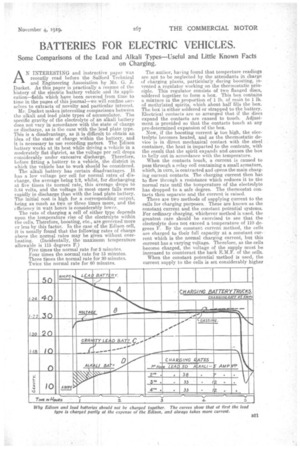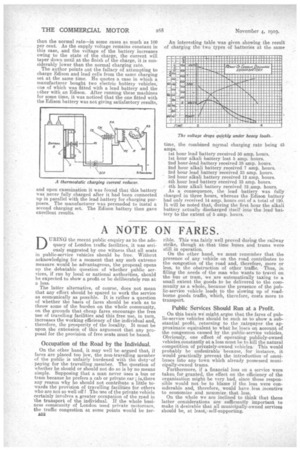BATTERIES FOR ELECTRIC VEHICLES.
Page 23

Page 24

If you've noticed an error in this article please click here to report it so we can fix it.
Some Comparisons of the Lead and Alkali Types—Useful and Little Known Facts on Charging.
AN INTERESTING and instructive paper was recently read before the Salford Technical and Engineering Association by Mr. G. J. Dueket. As this paper is practically a resume of the history of the electric battery vehicle and its application—fields which have been covered from time to time in. the pages of this journal----We will confine ourselves to extracts of novelty and particular interest. Mr. Ducket makes interesting comparisons between tho alkali and lead plate types of accumulator. The specific gravity of the electrolyte of an alkali battery does not vary in accordance with the state of charge or discharge, as is the case with the lead plate type. This is a disadvantage, as it is difficult to obtain an idea of the state of charge within the battery, and it is necessary to use recording meters. The :Edison battery works at its best while driving a vehicle in a moderately flat district, as the voltage per cell drops considerably under excessive discharge. Therefore, before fitting a battery to a vehicle, the district in which the vehicle has to work should be considered.
The alkali battery has certain disadvantages. It has a low voltage per cell for normal rates of discharge, the average being 1.2, whilst, for discharging at five times its normal rate, this average drops to 0.84 volts, arid the voltage in most cases falls more rapidly in discharge than with the lead plate battery. The initial cost is high for a corresponding output, being as much as two or three times more, and the efficiency in watt hours is considerably lower. The rate of charging a cell of either type depends upon the temperature rise of the electrolyte within the cells. Therefore, boosting, etc., are governed more or less by this factor. in the case of the Edison cell, it is usually found that the following rates of charge above the normal rates may be given without overheating. (Incidentally, the maximum temperature allowable is 115 degrees F.) Five times the normal rate for 5 minutes. Four times the normal rate for 15 minutes. Three times the normal rate for 30 minutes. Twice the normal rate for 60 minutes. The author, having found that temperture readings are apt to be neglected by the attendants in Charge of charging plants, particularly during boosting, invented a regulator working on the thermostatic priiaciple. This regulator consists of two flanged discs, soldered together to form a box. This box contains a mixture in the proportion of 1 lb. of resin to 1 lb. of methylated spirits, which about half fills the box. The box is either soldered or strapped to the battery. Electrical contacts are so arranged that if the discs expand the contacts are caused to touch. Adjustment is provided so that the contacts touch at any predetermined expansion of the box.
Now, if the boosting current is. too high, the electrolyte becomes heated, and as the thermostatic device is in direct mechanical contact with the steel container, the heat is imparted to the contents, with the result that the spirit expands and causes the box to belly out in accordance with the temperature.
When the contacts touch, a current is caused to pass through a relay coil containing a small armature, which, in turn, is contracted and opens the main charging current contacts. The charging current then has to flow through a resistance which reduces it to the normal rate until the temperature of the electrolyte has dropped to a safe degree. The thermostat contacts then separate and the current is raised.
There are two methods of supplying current to the cells for charging purposes. These are known as the constant current and the constant potential systems. For ordinary charging, whichever method is used, the greatest care should be exercised to see that the electrolyte does not exceed a temperature of 110 degrees F. By the constant current method, the cells are charged to their full capacity at a constant current which is the normal charging current, but this current has a varying voltage. Therefore, as the cells become charged, the voltage of the supply must he increased to counteract the back Fa M.F. of the cells.
When the constant potential method is used, the current supply to the cells is set considerably higher than the normal rate—in some cases as much as 100 per cent. As the supply voltage remains constant m this case, and the voltage of the battery increases owing to the state of the charge, the current will taper down until at the finish of the charge, it is considerably lower than the normal charging rate.. The author points out the. fallacy of attempting to charge Edison and lead cells from the same charging set at the same time. He quotes a case in which a manufacturer bought two electric battery vehicles, one of which was fitted with a lead battery and the other with an Edison. After running these machines for some time, it was noticed that the one fitted with the Edison battery was not giving satisfactory results,
and upon examination it was found that this battery was never fully .charged after it had been connected up in parallel with the lead battery for charging purposes. The manufacturer was persuaded to instal a second charging set. The Edison battery then gave excellent results.
An interesting table was given showing the result of charging the two types of batteries at the same time, the combined normal charging rate being amps.
1st hour lead battery received 50 amp. hours. 1st hour alkali battery lost 5 amp. hours.
2nd hour-lead battery received 38 amp. hours.
2nd hour alkali battery received 7 amp. hours. 3rd hour lead battery received 33 amp. hours. * 3rd hour alkali battery received 12 amp. hours.
4th hour lead battery received 33 amp. hours.
4th hour alkali battery received 12 amp. hours.
As a consequence, the lead battery was fully charged in three hours, whereas the Edson battery had only received 14 amp. hours out of a total of 120. It will be noted that, during the first hour the alkali battery actually discharged itself into the lead battery to the extent of 5 amp. hours. 45


























